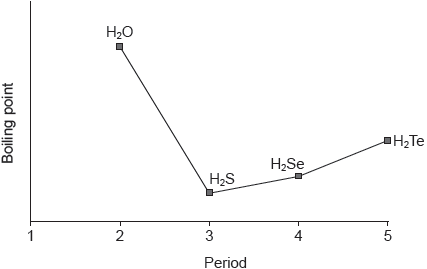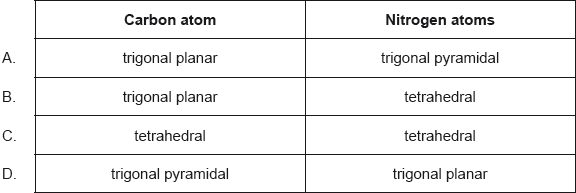| Date | May 2022 | Marks available | 1 | Reference code | 22M.2.sl.TZ2.4 |
| Level | SL | Paper | 2 | Time zone | TZ2 |
| Command term | Outline | Question number | 4 | Adapted from | N/A |
Question
Carbon forms many compounds.
C60 and diamond are allotropes of carbon.
But-2-ene reacts with hydrogen bromide.
Chlorine reacts with methane.
CH4 (g) + Cl2 (g) → CH3Cl (g) + HCl (g)
Outline one difference between the bonding of carbon atoms in C60 and diamond.
State two features showing that propane and butane are members of the same homologous series.
Describe a test and the expected result to indicate the presence of carbon–carbon double bonds.
Draw the full structural formula of but-2-ene.
Write the equation for the reaction between but-2-ene and hydrogen bromide.
State the type of reaction.
Suggest two differences in the 1H NMR of but-2-ene and the organic product from (d)(ii).
Calculate the enthalpy change of the reaction, ΔH, using section 11 of the data booklet.
Draw and label an enthalpy level diagram for this reaction.
Markscheme
C60 fullerene: «each carbon is» bonded to 3 C AND diamond: bonded to 4 C
OR
C60 fullerene: delocalized/resonance AND diamond: not delocalized/no resonance
OR
C60 fullerene: single and double bonds AND diamond: single bonds ✔
Accept “C60 fullerene: sp2 AND diamond: sp3”.
Accept “C60 fullerene: trigonal planar geometry / bond angles between 109.5°/109°/108°–120° AND diamond: tetrahedral geometry / bond angle 109.5°/109°”.
Accept "bonds in fullerene are shorter/stronger/have higher bond order".
same general formula / CnH2n+2 ✔
differ by CH2/common structural unit ✔
Accept "similar chemical properties".
Accept “gradation/gradual change in physical properties”.
ALTERNATIVE 1:
Test:
add bromine «water»/Br2 (aq) ✔
Result:
«orange/brown/yellow» to colourless/decolourised ✔
Do not accept “clear” for M2.
ALTERNATIVE 2:
Test:
add «acidified» KMnO4 ✔
Result:
«purple» to colourless/decolourised/brown ✔
Accept “colour change” for M2.
ALTERNATIVE 3:
Test:
add iodine / ✔
Result:
«brown» to colourless/decolourised ✔
Accept
CH3CH=CHCH3 (g) + HBr (g) → CH3CH2CHBrCH3 (l)
OR
C4H8 (g) + HBr (g) → C4H9Br (l) ✔
«electrophilic» addition/EA ✔
Do not accept nucleophilic or free radical addition.
ALTERNATIVE 1: Any two of:
but-2-ene: 2 signals AND product: 4 signals ✔
but-2-ene: «area ratio» 3:1/6:2 AND product: «area ratio» 3:3:2:1 ✔
product: «has signal at» 3.5-4.4 ppm «and but-2-ene: does not» ✔
but-2-ene: «has signal at» 4.5-6.0 ppm «and product: does not» ✔
ALTERNATIVE 2:
but-2-ene: doublet AND quartet/multiplet/4 ✔
product: doublet AND triplet AND quintet/5/multiplet AND sextet/6/multiplet ✔
Accept “product «has signal at» 1.3–1.4 ppm «and but-2-ene: does not»”.
bond breaking: C–H + Cl–Cl / 414 «kJ mol–1» + 242 «kJ mol–1»/656 «kJ»
OR
bond breaking: 4C–H + Cl–Cl / 4 × 414 «kJ mol–1» + 242 «kJ mol–1» / 1898 «kJ» ✔
bond forming: «C–Cl + H–Cl / 324 kJ mol–1 + 431 kJ mol–1» / 755 «kJ»
OR
bond forming: «3C–H + C–Cl + H–Cl / 3 × 414 «kJ mol–1» + 324 «kJ mol–1» + 431 kJ mol–1» / 1997 «kJ» ✔
«ΔH = bond breaking – bond forming = 656 kJ – 755 kJ» = –99 «kJ» ✔
Award [3] for correct final answer.
Award [2 max] for 99 «kJ».
reactants at higher enthalpy than products ✔
ΔH/-99 «kJ» labelled on arrow from reactants to products
OR
activation energy/Ea labelled on arrow from reactant to top of energy profile ✔
Accept a double headed arrow between reactants and products labelled as ΔH for M2.
Examiners report
This was a challenging question that asked about the difference between the bonding of carbon atoms in C60 and diamond. 20% of the candidates gained the mark. The majority of the candidates did not have a specific enough answer for C60 and mentioned the pentagons and hexagons but not the number of bonds or the geometry or the bond order or the electron delocalisation. Diamond was better known to candidates as expected.
About two-thirds of the candidates scored one of the two marks and stronger candidates scored both. The most common answers were the same general formula/CnH2n+2, the difference between the compounds was CH2 and similar chemical properties. The same functional group was not accepted since alkanes do not have a functional group. Some candidates only stated that they are saturated hydrocarbons not gaining any marks.
About half of the candidates gave the bromine water test with the correct results. Iodine and KMnO4 were rarely seen in the scripts. There were candidates who used the term “clear” to mean “colourless” which was not accepted. Some candidates referred to the presence of UV light in a correct way and others in an incorrect way which was not penalized in this case. 10% of the candidates left the question blank. The most common incorrect answer was in terms of the IR absorptions. Other candidates referred to enthalpies of combustion and formation.
A well answered question. 70% of the candidates gave the correct structural formula for but-2-ene. Mistakes included too many hydrogens in the structure and an incorrect position of the C=C. Candidates should be reminded that the full structural formula requires all covalent bonds to be shown.
Half of the candidates wrote the correct equation for the reaction of but-2-ene with hydrogen bromide. Incorrect answers included hydrogen as a product. As expected, the question correlated well with highly achieving candidates.
Well answered. 60% of candidates identified the type of reaction between but-2-ene and HBr, some of them including the term “electrophilic”. ECF was generously awarded when substitution was stated based on the equation where H2 was produced in part (ii). Candidates lost the mark if they only stated “hydrobromination” without mentioning addition. Some candidates lost the mark for stating “nucleophilic” or “free radical” addition.
The comparison of the 1H NMR spectra of the two organic compounds was more challenging and 10% of the candidates left this question blank. The average mark was 0.7 out of 2 marks. Mistakes included non-specific answers that just stated “more signals” or “higher chemical shift”, and stating 3 signals in 2-bromobutane instead of 4 signals. Standard level candidates were expected to use the number of signals and the ratio of the areas under the signals to answer the question since they do not cover chemical shift, however, many of them did use the 1H NMR section in the data booklet to obtain correct answers in terms of chemical shift.
This was the best answered question on the paper. Candidates identified the bonds and used bond enthalpies to calculate the enthalpy of reaction accurately. The most common mistakes were reversing the signs of bonds broken and bonds formed, assuming two Cl-Cl bonds were broken and using an incorrect value of bond enthalpy for one of the bonds.
The majority of candidates drew the enthalpy level diagram and labelled it correctly based on their answer to part (i). Some candidates reversed the products and reactants. A few candidates did not add any labels which prevented the awarding of the second mark. With 2 marks allocated to the question the second mark was awarded for correct labeling of either ΔH or Ea.



